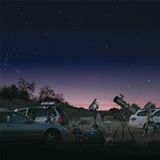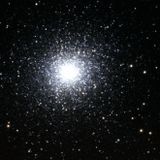
This weekend, with the third quarter moonrise cutting down our available observing time, let's maximize each view by selecting a few easy targets that give us "two-for-one" fun. Here are four pairs, each pair comprising objects that are at greatly divergent distances. As long as you get to a darker sky, each pair will be within the reach of even smaller instruments, like 6-8" telescopes. Of course, the larger your telescope, the more light it will gather, the brighter these objects will appear and the easier it will be to observe them!
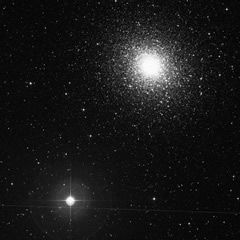 Start off in Serpens Caput, with the great globular cluster M5. Always a great sight, M5 competes in northern skies with M13 as the best of the best globulars. Pleasing enough by itself... but if you star hopped to it, you found it just with the star 5-Serpentis - which fits into a low power field of view with the globular. Look carefully at the bright star, less than half a degree southeast of the globular - it's a well known double! 5 Serpentis shines at magnitude 5.2, its components at 5.2 and 9.2, 2.1 arc minutes apart. 5 Serpentis is our close neighbor, only 80 light-years distant, while its eyepiece partner M5, still in our galaxy, is 24,500 light-years away.
Start off in Serpens Caput, with the great globular cluster M5. Always a great sight, M5 competes in northern skies with M13 as the best of the best globulars. Pleasing enough by itself... but if you star hopped to it, you found it just with the star 5-Serpentis - which fits into a low power field of view with the globular. Look carefully at the bright star, less than half a degree southeast of the globular - it's a well known double! 5 Serpentis shines at magnitude 5.2, its components at 5.2 and 9.2, 2.1 arc minutes apart. 5 Serpentis is our close neighbor, only 80 light-years distant, while its eyepiece partner M5, still in our galaxy, is 24,500 light-years away.
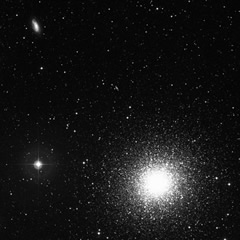 And speaking of M13, did you realize it too is a double-treat? It's always fun to compare M5 and M13 - which do you like best, and why? While viewing M13, check in your low power eyepiece just under a half degree north-northeast. See that "smudge"? It's the spiral galaxy NGC 6207, shining relatively brightly at magnitude 12.2. You should be able to determine its shape and size. M13 is listed at 21,000 light-years out, but its "little" buddy in the eyepiece... estimated at 22 million light-years. And you thought M13 was distant!
And speaking of M13, did you realize it too is a double-treat? It's always fun to compare M5 and M13 - which do you like best, and why? While viewing M13, check in your low power eyepiece just under a half degree north-northeast. See that "smudge"? It's the spiral galaxy NGC 6207, shining relatively brightly at magnitude 12.2. You should be able to determine its shape and size. M13 is listed at 21,000 light-years out, but its "little" buddy in the eyepiece... estimated at 22 million light-years. And you thought M13 was distant!
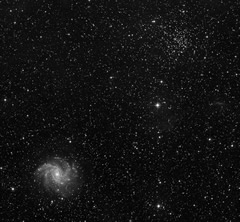 Here's an interesting pair - NGC 6946 and NGC 6939 - you'll need a good wide field to fit both in one view, but it's well worth it. NGC 6939 is a rich open cluster, in our own Milky Way galaxy. It shines at magnitude 7.4, but its large size makes it seem dimmer. Just over half a degree southeast is the "Firecracker Galaxy," NGC 6946. Large and dim, it will appear as a faint haze, but with averted vision and patience, some of its spiral structure will show. Oh... the Firecracker? NGC 6946 has more recorded supernovae than any other galaxy! The open cluster is a mere 4,000 light-years away, while its "neighbor" is at 22 million light-years.
Here's an interesting pair - NGC 6946 and NGC 6939 - you'll need a good wide field to fit both in one view, but it's well worth it. NGC 6939 is a rich open cluster, in our own Milky Way galaxy. It shines at magnitude 7.4, but its large size makes it seem dimmer. Just over half a degree southeast is the "Firecracker Galaxy," NGC 6946. Large and dim, it will appear as a faint haze, but with averted vision and patience, some of its spiral structure will show. Oh... the Firecracker? NGC 6946 has more recorded supernovae than any other galaxy! The open cluster is a mere 4,000 light-years away, while its "neighbor" is at 22 million light-years.
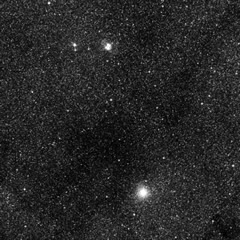 Here's a final fun "faint-fuzzy" pair. NGC 6440 and NGC 6445 are two galactic targets in our own Milky Way galaxy, in the constellation Sagittarius. When viewed together in a telescope, they appear quite similar. But NGC 6440 is a planetary nebula, while NGC 6445 is an "unresolved" (you can't see the individual stars) globular cluster. Separated by just 21 minutes, their magnitudes are 13 and 9.7, with distances estimated at 4,500 and 27,700 light-years. Try an Orion Ultrablock filter here to see the planetary jump out!
Here's a final fun "faint-fuzzy" pair. NGC 6440 and NGC 6445 are two galactic targets in our own Milky Way galaxy, in the constellation Sagittarius. When viewed together in a telescope, they appear quite similar. But NGC 6440 is a planetary nebula, while NGC 6445 is an "unresolved" (you can't see the individual stars) globular cluster. Separated by just 21 minutes, their magnitudes are 13 and 9.7, with distances estimated at 4,500 and 27,700 light-years. Try an Orion Ultrablock filter here to see the planetary jump out!
Do you have any other divergent eyepiece pairs you'd like to tell us about? Or, submit a comment with your impressions of these pairs.
Mark Wagner is a life-long astronomy enthusiast and deep sky observer. He has spent the past twenty years popularizing amateur astronomy in the San Francisco bay area through his writing and community building. A past president of the San Jose Astronomical Association, he founded what is now the annual Golden State Star Party in California. Please post if you have comments, questions, sketches or images you've taken of the targets mentioned above.




